Wagyu around the World - Japan
Population of Wagyu, beef production and imports
Over centuries, cattle have been treated like members of the family as only a few head were raised on each farm. 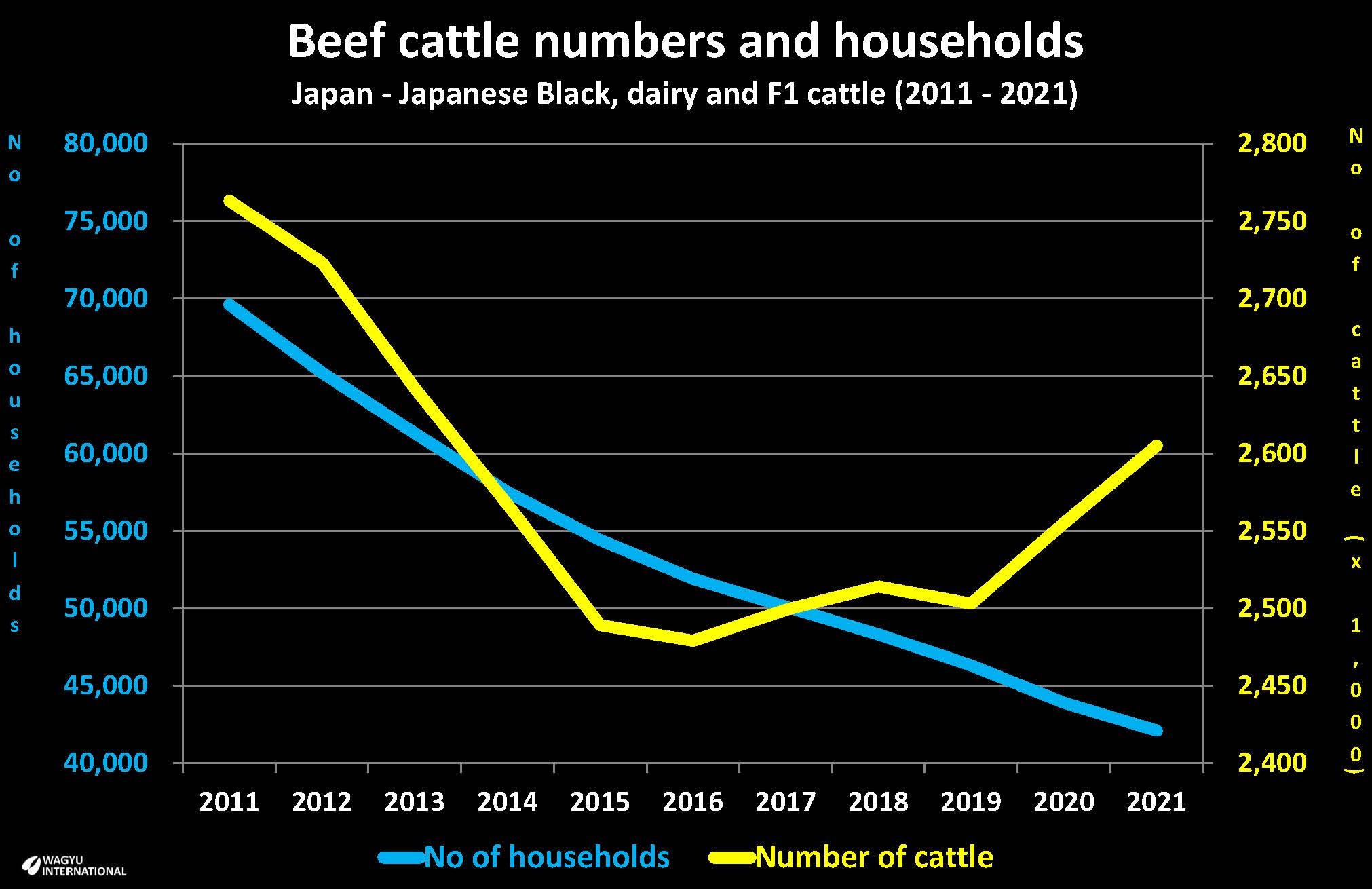 When housed for protection against the elements, the sheds are well ventilated and the floor covered with saw dust. Fresh water is crucial so always provided. Cattle are carefully brushed with a stiff brush to improve blood circulation and to keep the coat in good condition. Some producers brush with Sake (beer) to improve the appearance and softness of the coat. Massaging is another indication of the closeness the farmer has to their precious cattle and is carried out to relieve stress and muscle stiffness.
When housed for protection against the elements, the sheds are well ventilated and the floor covered with saw dust. Fresh water is crucial so always provided. Cattle are carefully brushed with a stiff brush to improve blood circulation and to keep the coat in good condition. Some producers brush with Sake (beer) to improve the appearance and softness of the coat. Massaging is another indication of the closeness the farmer has to their precious cattle and is carried out to relieve stress and muscle stiffness.
In the hottest months Sake beer is fed to stimulate appetite.
The constant handling of cattle ensures that they are relaxed so never exposed to stress and are relaxed with the presence of humans. High fibre foods – like hay, wheat bran, corn and soybean by-products are fed for prolonged periods but the average daily gain of Japanese cattle is modest - compared with other beef breeds – but in the final phase there is a reduction in roughage.
Japan had 53,000 beef producers in 2013 but this dropped after the foot-and-mouth outbreak and has slipped around 5% a year. Ageing breeders with no heirs to take over and rising feed prices were the major factors. Over ten years there has been an increase in the share of corporation management entities from 15 to 27% in 2015. Beef cattle numbers have increased since 2015 with the average herd size rising to 60 in 2021.
In 2007 there were 2.8 million head of beef cattle, including 1 700 000 traditional Wagyu. 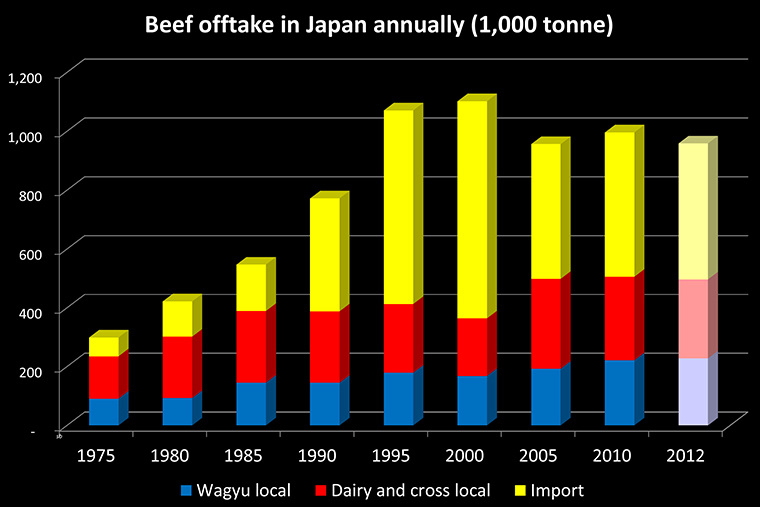 This is a huge increase over 40 years when there were only a million head with a few cattle on each farm. While herd sizes grew and the number of farms declined, the number of cattle grew until the peak just short of 3 million was reached in 1995.
This is a huge increase over 40 years when there were only a million head with a few cattle on each farm. While herd sizes grew and the number of farms declined, the number of cattle grew until the peak just short of 3 million was reached in 1995.
BSE cases in 2001 did not have a significant effect on domestic cattle numbers despite restrictions on trade. The outbreak of Foot and Mouth in Miyazaki Prefecture in April 2010 had a severe impact on local breeding herds as not even elite genetics was spared from the mandatory slaughter which was imposed to eradicate the disease.
The tsunami of 2011 tragically took 15,840 human lives with more missing. ¥14 billion in value of crops and livestock was destroyed with damage and losses in the Tōhoku, Kantō and Chūbu regions. 17,000 hectares could not be planted in 2011 as a result of damage caused by the waves of the tsunami. 4,000 hectares were reclaimed during 2012. Consumer confidence was dented by radiation from Fukushima. Meat imports into Japan during 2011 increased 4% while the consumption of domestic beef declined 3%.
Despite producing the ultimate beef quality across the globe, beef consumption in Japan is relatively low and reached its peak of 7.5 kg per capita in the late 1990s. This is a dramatic increase from 1.2 kg in 1960 and 5.4 kg in 1988. Beef consumption had slipped to 5.9 kg/head full year 2012. Pork was 11.8 while poultry had topped at 12 kg after a 5% increase (MLA 2013). 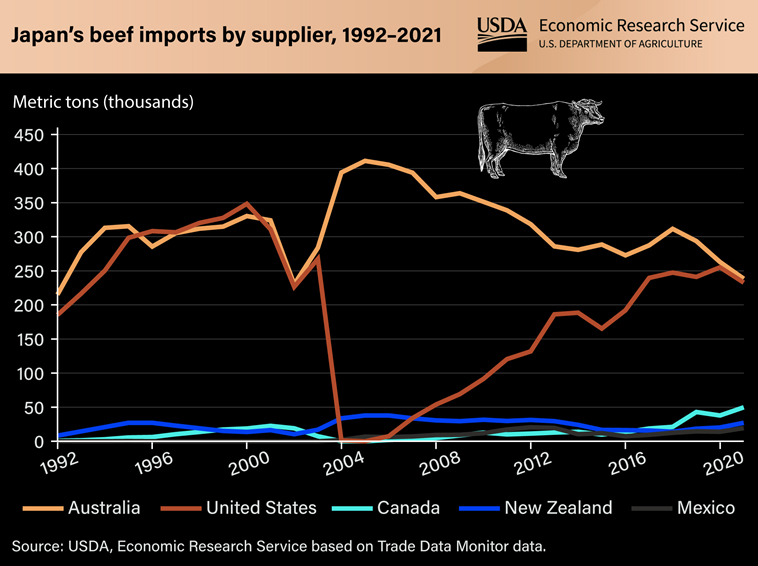 The best quality of beef in Japan is supplied domestically but 60% of beef consumption is from imports as imported beef provides a cheaper alternative. The increase in beef imports from 1991 after the liberalization of trade is reflected in trends of offtake over time (from MAFF and MLA).
The best quality of beef in Japan is supplied domestically but 60% of beef consumption is from imports as imported beef provides a cheaper alternative. The increase in beef imports from 1991 after the liberalization of trade is reflected in trends of offtake over time (from MAFF and MLA).
Australia’s share of the Japanese beef market by volume has reduced from 51.3% in 2018 to 40.1% in 2021. This is due to increased competition from the US, Canada, New Zealand and Mexico, and herd rebuilding by Australian farmers.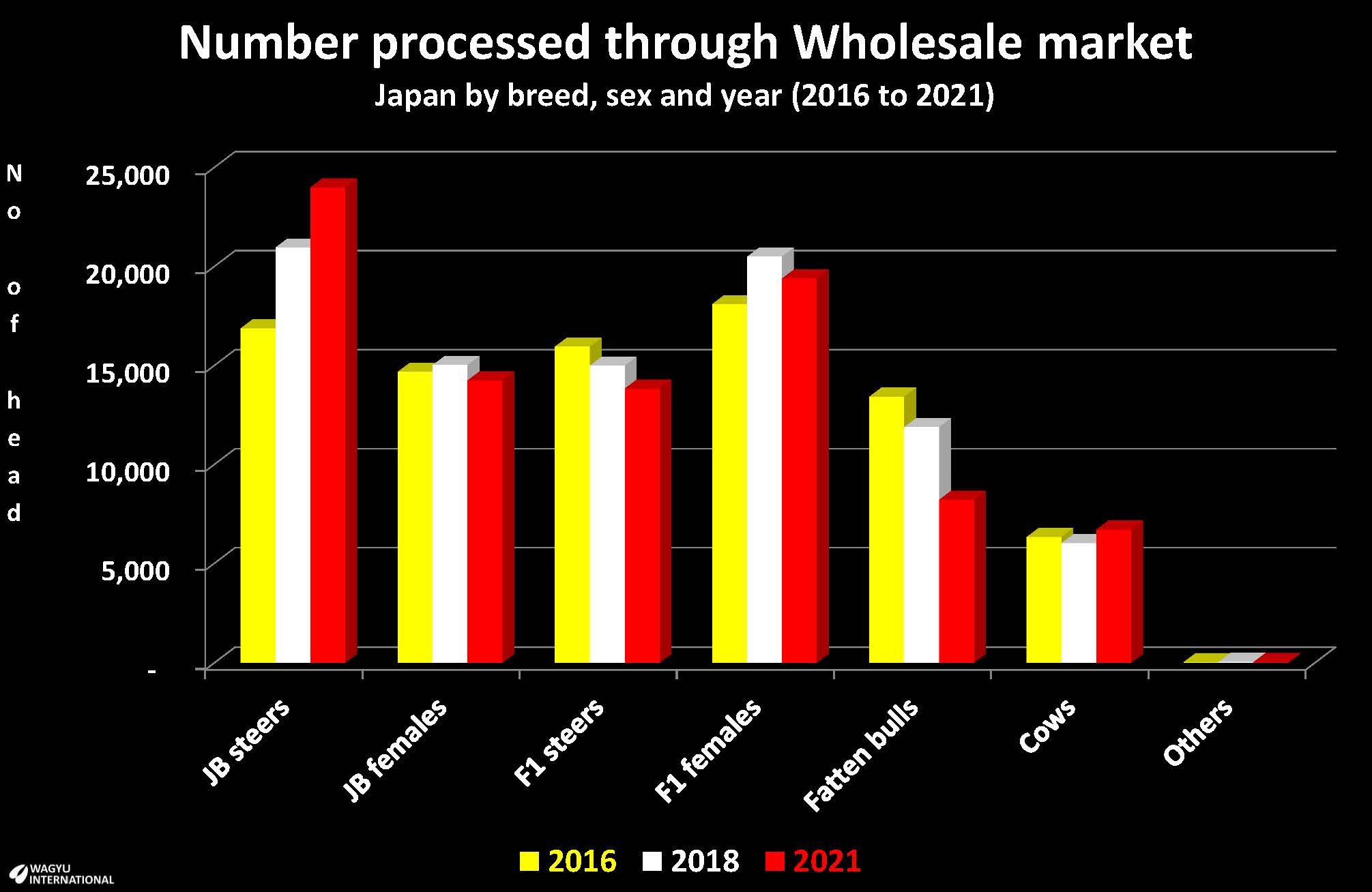
Recent domestic production is shown in this chart of the Wholesale market through to the end of 2021. The split of Japanese Black steers and females, F1 holstein and Holstein steers from dairies is shown. The delivery of fattened dairy bulls is declining and decreases in F1 holstein steers have been substituted by Japanese Black steers.
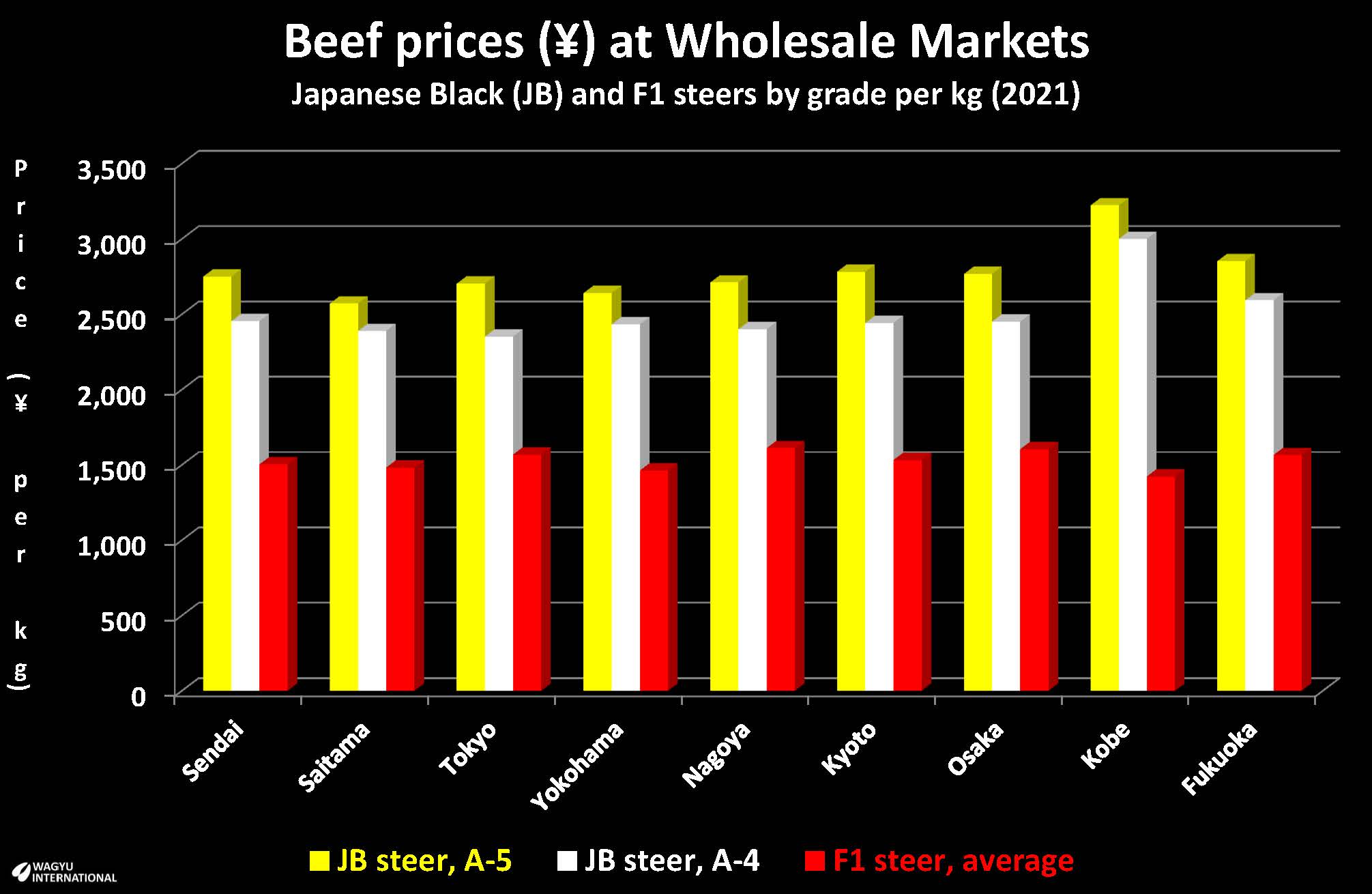 Soaring feed prices and damage from the 2011 earthquake led to record cattle prices and concerns over maintaining a stable supply.
Soaring feed prices and damage from the 2011 earthquake led to record cattle prices and concerns over maintaining a stable supply.
Prices paid to the wholesale market vary by location and grade. Japanese Black graded A-4 earns a premium. The average price paid for Japanese Black steers is between the A-5 and A-4 price so this implies that the quality of beef passing through the wholesale markets is of a very high standard. Highest prices were paid over 2021 at Kobe wholesale market where it is observed that the lowest average F1 price was paid.
The national average price for each livestock class from the entire wholesale trade is tabled:
| Wholesale Markets average price full year 2021 | ||
Class and sex |
2018 |
2021 |
Japanese Black, steers |
2,617 |
2,724 |
Japanese Black, females |
2,334 |
2,412 |
F1 holstein, steers |
1,519 |
1,606 |
F1 holstein, females |
1,461 |
1,567 |
Fattened dairy bulls |
1,046 |
1,092 |
Other females |
579 |
639 |
The average wholesale price for a Japanese Black steer was highest in Gifu and it was ¥1,481,938.94 per head in 2021. The national average was ¥1,378,575. Despite this high price, many producers do not cover costs so a subsidy is paid to producers that carrying out the feeding. A factor for different input costs applies to each prefecture so that there is a universal margin.
Feed costs accounted for about 30 to 60% of operating costs for livestock farming in Japan in 2021. Emergency measures were implemeneted using a contingency fund and supplementary budgets. Criteria to trigger the supplemental compensation fund have been lowered and compensation is provided to livestock farmers who are working to reduce production costs and improve feed self-sufficiency ratio.
The three grains, maize, soybeans and wheat, account for 1.43 trillion yen out of Japan’s total imports of 9.2 trillion yen in full year 2022. This is an increase of 31.2% from the previous year reflecting higher unit import prices, especially for food for human and feed for livestock due in part to the impact of exchange rates while the volume increased slightly.
Export values of agricultural, forestry, and fishery products and food in 2022 increased by 14.3% from the previous year to a record high of 1.4 trillion yen, due to a recovery in demand for eating-out as well as the impact of foreign exchange rate.
The export strategy was revised in December 2022 to achieve target export values of 2 trillion yen by 2025 and 5 trillion yen by 2025.
Wagyu breeds in Japan
The three modern breeds Japanese Black, Japanese Brown (Kochi strain)/Akaushi and Japanese Polled were established by the Wagyu Registry Association in 1944 (Namikawa, K., 1992).
The Japanese Shorthorn Cattle Registry Association was established in 1957. Initially the breed had been registered in Iwate as Tohoku Brown.
Detailed descriptions for these breeds can be viewed on this page, click here.
| Names in Japan | Global names |
| Japanese Black | Black Wagyu |
Japanese Brown / Akaushi |
Red Wagyu / Akaushi Kumamoto Kochi |
| Japanese Poll | Wagyu Polled |
| Japanese Shorthorn | Wagyu Shorthorn |
Native cattle breeds of Japan
There are only two isolated populations of native cattle that were not improved through crossbreeding so they are not classified as Wagyu in Japan. 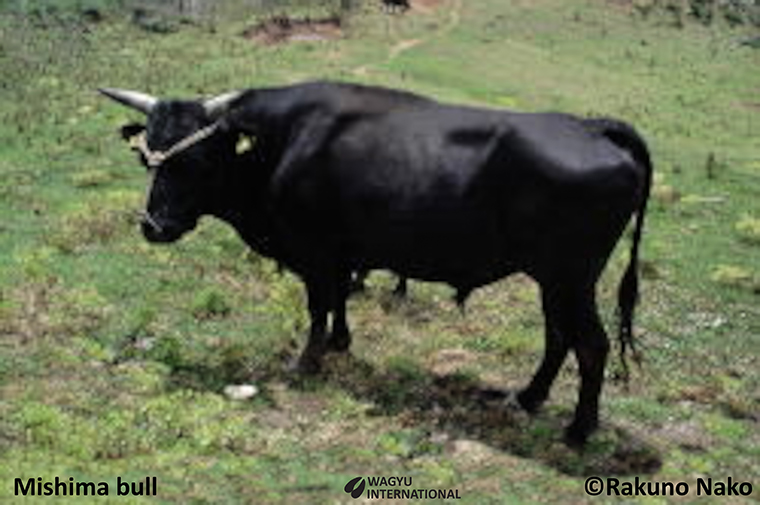
The native cattle on Mishima Island (located in the Sea of Japan off Yamaguchi Prefecture with an area of 6.7 km squared with limited flat ground) were closed so they are small in size with a good temperament. Mitsuru Minezawa reported that the original herd of 350 were annihilated for rinderpest in 1672. Native cattle from mainland Japan were re-introduced from the Chugoku Region on the Japanese mainland shortly after decimation.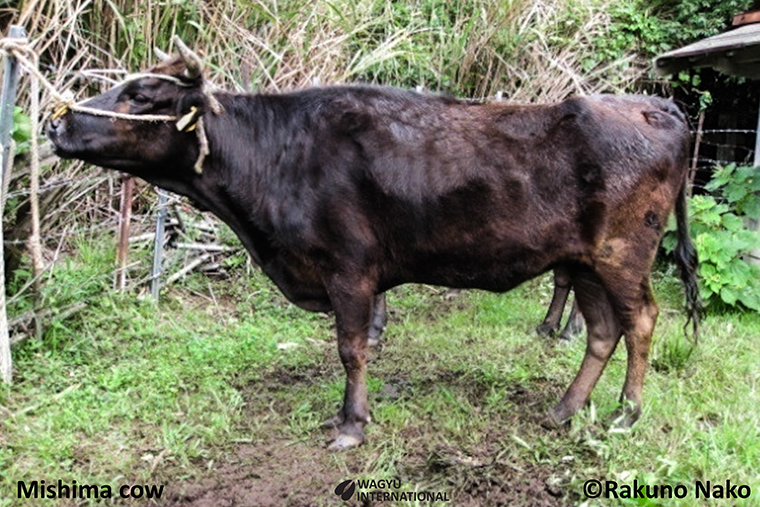 The new cattle population on Mishima Island had built up to 433 by 1739. They were protected as a natural monument by government decree in 1928 as their numbers were starting to dwindle from the peak of 568 in 1917 and at one time there were only 33 breeding females. By 2000 Mishima had grown to number 100. A mature 60 month old Mishima cow weighs 261 kg. Semen is used for a terminal cross over Holstein on the mainland to produce "Ken Ran Gyu".
The new cattle population on Mishima Island had built up to 433 by 1739. They were protected as a natural monument by government decree in 1928 as their numbers were starting to dwindle from the peak of 568 in 1917 and at one time there were only 33 breeding females. By 2000 Mishima had grown to number 100. A mature 60 month old Mishima cow weighs 261 kg. Semen is used for a terminal cross over Holstein on the mainland to produce "Ken Ran Gyu".
Inbreeding is estimated to be between 0.51 and 0.60 in Mishima. Despite this, there are no indications of inbreeding depression of reproductive traits. Heterozygosity measures genetic diversity and is recorded to be 22.9% in Mishima. Japanese Black is 48.8% while Japanese Brown is 61.2% (Nagamine et al., 2008).
The second herd that escaped improvement from crossbreeding were escapees that became feral. Some Japanese native cattle were introduced to Kuchinoshima Island in Kagoshima prefecture in 1918 or 1919. 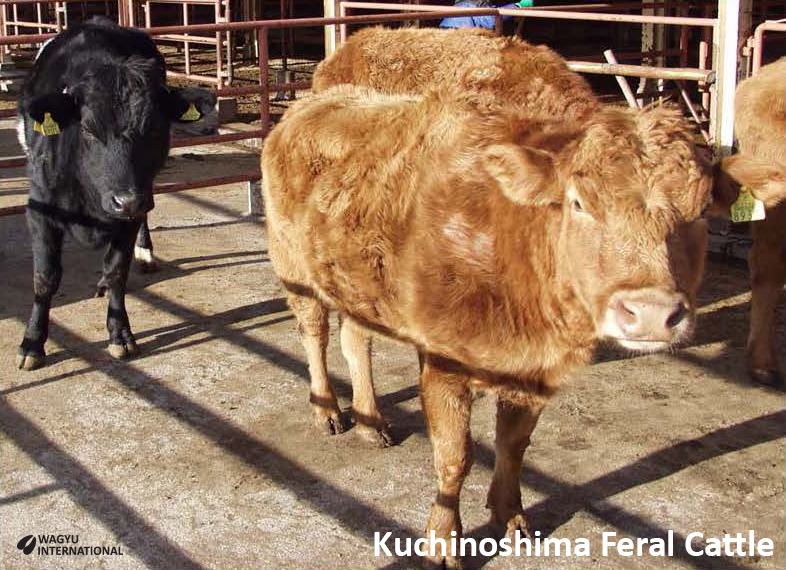 Some of these animals escaped to the mountains and became the founders of Kuchinoshima Feral Cattle. They are a small population of fewer than 200 and have been subject to significant inbreeding. The extremely low genetic diversity is due to the founder effect from only a few ancestral individuals and genetic drift from a small population. In 2001 there were 20 head in a herd at Kagoshima University and another 24 at Nagoya University. In spite of this, there is still coat-colour variation. The coat is mainly black with a white spot on the belly and/or on four limbs. Occasionally brown colour occurs. The size is smaller than Mishima and the carcass is lean so there is no marbling.
Some of these animals escaped to the mountains and became the founders of Kuchinoshima Feral Cattle. They are a small population of fewer than 200 and have been subject to significant inbreeding. The extremely low genetic diversity is due to the founder effect from only a few ancestral individuals and genetic drift from a small population. In 2001 there were 20 head in a herd at Kagoshima University and another 24 at Nagoya University. In spite of this, there is still coat-colour variation. The coat is mainly black with a white spot on the belly and/or on four limbs. Occasionally brown colour occurs. The size is smaller than Mishima and the carcass is lean so there is no marbling.
Grading of beef in Japan
A number of measurements and observations are made before the two index class is awarded. Yield is measured and quality is determined after evaluation of marbling, meat colour and brightness, firmness and texture of meat, and colour, lustre, and quality of fat.
Yield grade is the proportion of meat available and measurements are taken at the 6th to 7th rib section. 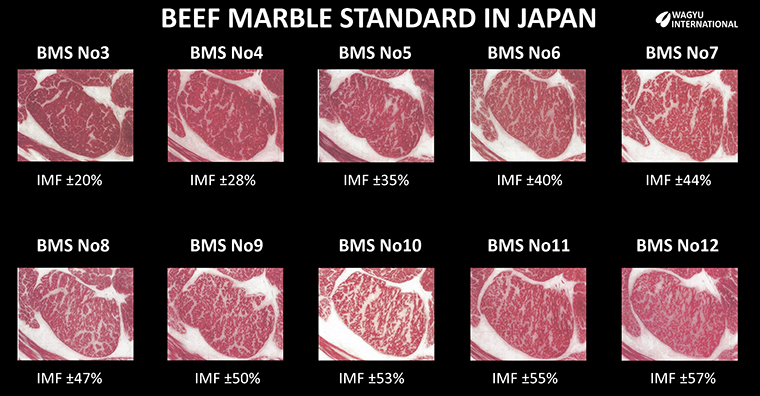 Rib-eye area, rib thickness, cold left side weight and subcutaneous fat thickness are analysed in a formula. Yield is designated by a letter. Grade B is “standard” and awarded for a yield estimate which falls between 69 and 72%. Grade A is “above standard” and C is “below standard”.
Rib-eye area, rib thickness, cold left side weight and subcutaneous fat thickness are analysed in a formula. Yield is designated by a letter. Grade B is “standard” and awarded for a yield estimate which falls between 69 and 72%. Grade A is “above standard” and C is “below standard”.
Beef Marble Standard "BMS" is an assessment of marbling against standards. The allocation of beef marbling grade from the BMS number is tabled (JMGA):
The colour and brightness of meat is evaluated by the Beef Colour Standard “BCS”. The colour is allocated visually to standards numbered from 1 (light) to 7 (darkest). Most desirable are within the range from 3 to 5. Brightness is also visually ranked between “below average” to “very good”. These two rankings are used to determine the colour and brightness grade which ranges from 1 (inferior) to 5 (very good). Average is Grade 3.

Firmness and texture of meat are evaluated visually. Firmness is scored from 1 (inferior) to 5 (very good) and texture from 1 (coarse) to the best of 5 (very fine). Both results are considered before a Firmness and Texture Grade is awarded from 1 (Inferior) to 5 (Very good).
The colour, lustre and fat quality are evaluated. The Beef Fat Standard (BFS) ranges from No 1 (light colour) to No 7 (darkest). Lustre and quality are also visually rated between “below average” to the highest 5 “very good”. The Fat Colour, Lustre and Quality Grade is given and ranges from 1 (Inferior) to 5 (Excellent).
Champions from exhibitions earn premiums. The Matsusaka winner in December 2012 earned ¥22 million at four years of age after 1,134 days on feed.
The marbling content (IMF%) is exceptionally high in Japan. Comparative minimum levels of IMF% for BMS in Japan, Marble Score in Australia, and in Prime, Choice and Select in Australia is illustrated:
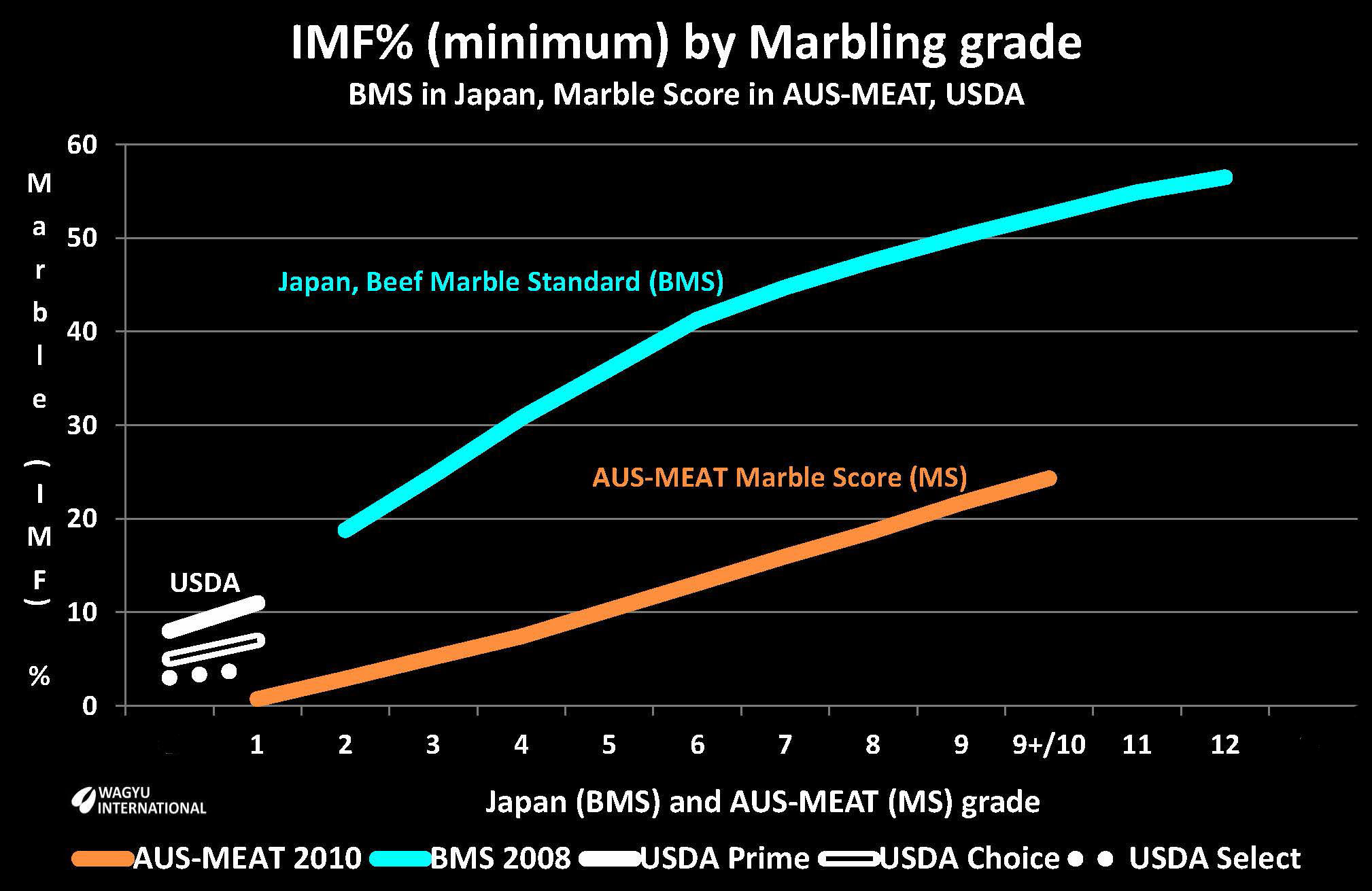
Beef brands in Japan
Wagyu is synonymous with the ultimate beef experience around the world, but the quality from Japan is unsurpassed. Numerous brands are well established and a seal of authenticity is provided at retail and information can be downloaded by keying a serial number into a mobile phone.
Elite brands are called "Sandai Wagyu" and are from the Tajima strain of Japanese Black. The best known are Kobe, Matsusaka and Ōmi beef.
Tajima-gyu (田島圭) is from pure Tajima beef “motoushi” which is processed at a Hyogo slaughterhouse from steers or virgin heifers between the ages of 28 and 60 months which have been sired by bulls exclusive to Hyogo Prefecture. Tajima-gyu must be either A or B grade for Yield and Quality grade inclusive of 1 to 5. About 5 500 head are certified each year.
Kobe beef (Kobe-gyu or Kobe-ushi) derives solely from Tajima-gyu steers or heifers and only 3,000 are certified annually. The following standards apply (Kobe Beef website):
- Meat quality score of 4 or above, and Yield grade of A or B.
- BMS score of 6 or above.
- Steers are 250 to 470 kg carcase weight and heifers range 230 to 470 kg.
- The carcase is evaluated for flaws by a Council commissioned consignee who confirms if it can be certified “Kobe beef”.
Kobe beef may be the best known Wagyu brand outside Japan, but Matsusaka beef (Matsuzaka) is highly sought after within Japan. Matsusaka ushi 松阪牛 is certified by a seal which is attached to over-the-counter produce. A 10-digit reference number is downloaded onto the internet or by a mobile phone to obtain: date of birth, name of breeder, place of birth, pedigree, number of days on feed, place of fattening, name of farmer who finished, and quality specifications. “Matsusaka beef” comes from 8 month old heifer calves which are purchased across Japan then registered with the Matsusaka beef council. They are raised within the former municipality 22 which centred on the city of Matsusaka. Matsusaka beef has a very low melting point so it can melt in the palm of a hand (Matsusaka Beef website).
Ōmi beef is produced in the Shiga Prefecture in Kansai Region. The high level of marbling is characterised by softness and a mellow flavour and the meat “just melts”. This has earned Ōmi beef its reputation and the Ōmi beef trademark was registered in Japan on 11th May 2007. Carcases require to be graded A4 or A5 or higher at specific processors.
Yonezawa beef, cow Tamba, Kumamoto Sum King Black and a few other Kumamoto brands, Hitachi cow, Wagyu Kazusa and Miyazaka are amongst many other prestigious beef brands in Japan.
Wagyu vending machine in Okayama
A vending machine offering vacuum-sealed frozen packs of brand-name wagyu beef grown locally is drawing plenty of buyers in the west Japan city of Okayama.
Morioka meat shop offers Japanese Black wagyu beef at affordable prices from its vending machine in one of the city’s shopping districts. The machine is stocked with seven cuts and packages of Tsuyama wagyu beef items, including steak and burger patties. Prices range from ¥1,000 to ¥2,000 (roughly US$7 - 14).
Owner Hideki Morioka said he set up the vending — which has proven popular in various locations in the United States and France — in order to help out the local cattle farmers.
The vending machine reportedly sells out regularly. It also has proven to be a lead generator for Morioka’s retail and online shops.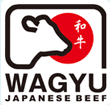
Wagyu born and raised in Japan
Wagyu beef that has been born and raised in Japan
has this logo affixed to confirm that it originates in Japan.
Additional information
Japan Meat Grading Association
Ministry of Agriculture, Forestry and Fisheries
References
Brunson, K., et al., 2016. New insights into the origins of oracle bone divination: Ancient DNA from Late Neolithic Chinese bovines. Journal of Archeological Science (74) 35-44.
Japan Meat Grading Association.
Lim, Kyu-Sang, Park, B., Choi, T., Lim, D. and Y Cho, 2016. Carrier testing for autosomal recessive hereditary disorder in Korean proven bulls. J Bio Trans Res, (17) 4:85-90.
Mannen, H., Kohno, H., Nagata. Y., Tsuji, S., Bradley, D. G., Yeo, J. S., Nyamsamba, D., Zagdsuren, Y., Yokohama, M., Nomura, K. and T. Amano. 2004. Independent mitochondrial origin and historical genetic differentiation in North Eastern Asian cattle. Molecular Phytogenetics and Evolution. 32:539-544.
Mannen, H., Yonezawa, T., Murata, K., Noda, A., Kawaguchi, F., Sasazaki, S., Olivieri, A., Achilli, A and A. Torroni, 2020. Cattle mitogenome variation reveals a post-glacial expandsion of haplogroup P and an early incorporation into northeast Asian domestic herds. www.nature.com/scientificreports https://doi.org/10.1038/s41598-020-78040-8
McKay, S. D. , Schnabel, R. D. , Murdoch, B. M. , Matukumalli, L. K. , Aerts, J. , Coppieters, W. , Crews, D. , Dias Neto, E. , Gill, C. A. , Gao, C. , Mannen, H. , Wang, Z. , van Tassell, C. P. , Williams, J. L. , Taylor, J. F. and S. S. Moore. 2008. An assessment of population structure in eight breeds of cattle using a whole genome SNP panel. BMC Genetics 9:37.
Meat and Livestock Australia.
Meat & Livestock Australia/Prices & Markets. 2013. Chicken tops Japan meat consumption.
Minezawa, M. 2003. Cattle genetic resources in Japan: One successful crossbreeding story and genetic diversity erosion. Cattle Genetic Resources in Japan. 4 (2):71-87.
Ministry of Agriculture, Forestry and Fisheries. Website.
Nagamine, Y., Nirasawa, K., Takahashi, H., Sasaki, O., Ishii, K, Minezawa, M., Oda, S., Visscher, P.M. and Furukawa, T. 2008. Estimation of the time of divergence between Japanese Mishima Island cattle and other cattle populations using microsatellite DNA markers. J. Hered. 99(2):202-207.
Namikawa, K. 1992. Breeding history of Japanese Beef cattle and preservation of genetic resources as economic farm animals. Wagyu. 2nd ed. Wagyu Registry Assoc., Kyoto, Japan.
Nikkei Asian Review. 2013. Imported beef prices on the rise in Japan. Markets/Commodities/ 30th November 2013.
Noda, A. Yonesaka, R., Sasazaki, S., H. Manneen, 2018. The mtDNA haplogroup P of modern Asian cattle: A genetic legacy of Asian aurochs?
Nomura, T., Honda, T. and F. Mukai. 2001. Inbreding and effective population size of Japanese Black cattle. J. Anim. Sci. 79:366-370.
Oyama, K. 2011. Genetic variability of Wagyu cattle estimated by statistical approaches. An. Sci. J. 82:367-373.
Sasaki, Y., Miyake, T., and T. Dougo. 2006. Comparison of genetic gains per year for carcass traits among breding programs in the Japanese Brown and the Japanese Black cattle. J. Anim. Sci. 84:317-323.
Shojo, M., Okanishi, T., Anada, K., Oyama, K. and F. Mukai. 2006. Genetic analysis of calf market weight and carcass traits in Japanese Black cattle. J. Anim. Sci. 84:2617-2622.
Xia, X, K. Qu, G. Zhang, Y. Jia, Z. Ma, X. Zhao, Y. Huang, H. Chen, B. Huang, C. Lei, 2019. Comprehensive analysis of the mitochondrial DNA diversity in Chinese cattle. Wiley online library.
DISCLAIMER Wagyu International provides information that has been supplied by other parties and gives no warranty (express or implied) as to the data completeness, accuracy or fitness for a particular purpose.
